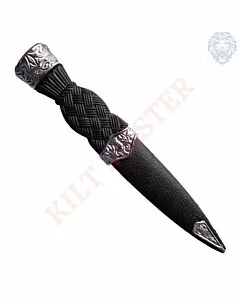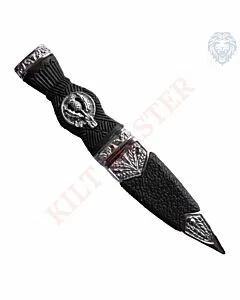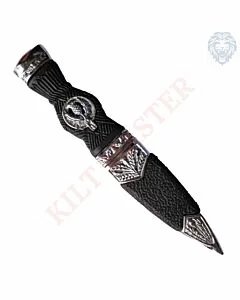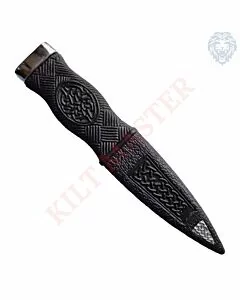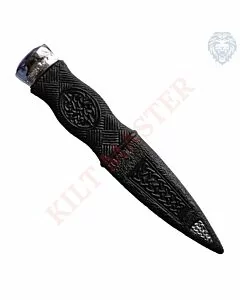Sgian Dubhs
Accessories

- Cross Hatch Sgian DubhSpecial Price $24.29 Regular Price $26.99
- Thistle Sgian DubhSpecial Price $24.29 Regular Price $26.99
- Stone Head Thistle Sgian DubhSpecial Price $25.19 Regular Price $27.99
- Stone Head Sgian DubhSpecial Price $24.29 Regular Price $26.99
- Highland Thistle Buckle for BeltSpecial Price $9.90 Regular Price $11.00
The Sgian Dubhs are a small single-edged knife that has its origins in Scotland. The name Sgian-Dubh (pronounced 'ski-en doo') comes from the Gaelic language, and it literally means 'black knife'.The Sgian-Dubh is said to have originally been part of a set of knives that were used by servants to clean, skin, and dress the meat after the Lord of the manor and his party had been out hunting game.
Nowadays, the Sgian Dubh is worn as part of traditional Scottish dress, often tucked into the top of the kilt hose. It is usually positioned so that only the hilt (handle) is visible. In the modern highland outfit, the Sgian-Dubh has taken on more of an aesthetic role than a practical one, adding a touch of decoration to the Kilt Hose. If you are looking for a Sgian-Dubh, Kilt master offers a wide range of Sgian Dubhs to choose from. We have Sgian Dubhs in a variety of different materials, including wood, bone, and antler. We also have Sgian Dubhs with a range of different designs, so you are sure to find one that suits your personal style. Whatever design or material you decide to go for, you will end up with a quality Sgian Dubh that will last you for years to come. With kilt master
Etymology and spelling
The name comes from the Scottish Gaelic sgian-dubh. Although the primary meaning of dubh is "black", the secondary meaning of "hidden" is at the root of sgian-dubh, based on the stories and theories surrounding the knife's origin, in particular those associated with the Highland custom of depositing weapons at the entrance to a house prior to entering as a guest. Compare also other Gaelic word-formations such as dubh-sgeir "underwater skerry" (lit. black skerry), dubh-fhacal "riddle" (lit. hidden word), dubh-cheist "enigma" (lit. hidden question).
The Origins of Sgian Dubh
The sgian-dubh may have evolved from the sgian-achlais, a dagger that could be concealed under the armpit. Used by the Scots of the 17th and 18th centuries, this knife was slightly larger than the average modern sgian-dubh and was carried in the upper sleeve or lining of the body of the jacket
Construction of Sgian Dubh
The early blades varied in construction, some having a "clipped" (famously found on the Bowie knife) or "drop" point. The "spear-point" tip has now become universal. The earliest known blades, some housed in the National Museum of Scotland in Edinburgh, are made from German or Scandinavian steel, which was highly prized by the Highlanders. Scalloped filework on the back of the blade is common on all Scottish knives. A short blade of 3 to 3.5 inches (7.5 to 9 cm) is typical.
If you have any questions about Sgian Dubhs, or if you would like help choosing the right Sgian Dubh for your outfit, please do not hesitate to contact us. Our friendly and knowledgeable staff will be happy to assist you.
